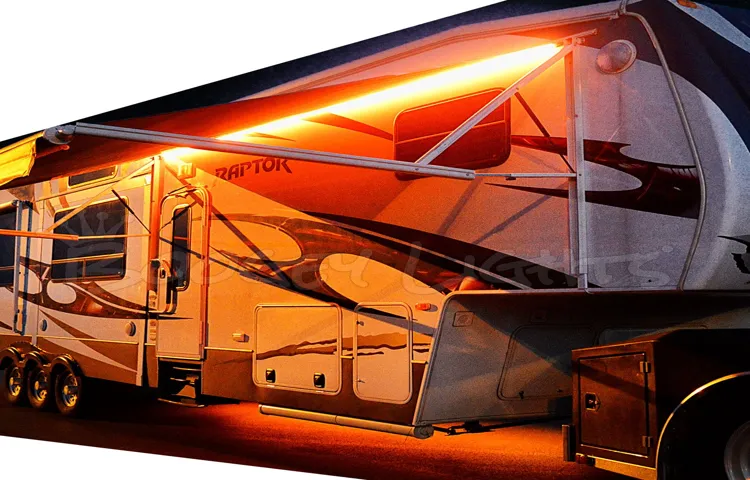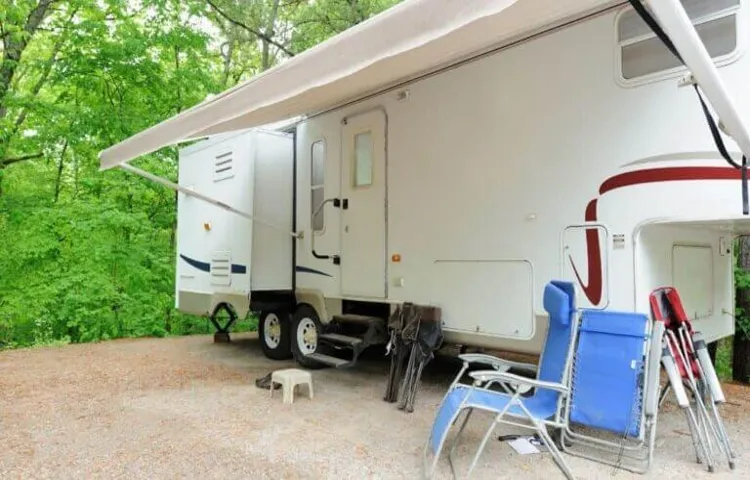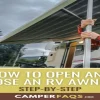So, you’ve got yourself an RV and you’re ready to hit the open road. One of the best things about traveling in an RV is enjoying the great outdoors, and what better way to do that than with an RV awning? But if you’re new to RVing, you might be wondering: how do I use an RV awning? Don’t worry, we’ve got you covered. In this post, we’ll take you through everything you need to know about using your RV awning, from setting it up to taking it down.
So sit back, relax, and let’s get started!
Table of Contents
Step 1: Setting Up the Awning
Using an RV awning can greatly enhance your camping experience by providing shade and protection from the elements. The first step in using an RV awning is to set it up properly. Start by positioning your RV in a spot where there is plenty of room for the awning to fully extend.
Locate the awning controls, which are usually found on the outside of your RV. Make sure the awning is securely fastened to the RV and that all support legs are in place. Next, extend the awning slowly and evenly, being careful not to allow the fabric to become twisted or tangled.
Once the awning is fully extended, adjust the angle to provide the desired amount of shade. Congratulations, you’re well on your way to enjoying your RV awning!
Locate the awning on the RV
When setting up the awning on your RV, the first step is to locate where it is. Most RVs have a section of the vehicle specifically designated for the awning, usually on the passenger side of the vehicle. The awning will be stored in a long, cylindrical casing, which will be attached to the RV.
Once you’ve found the casing, you can begin the process of setting up the awning itself. It’s important to take your time during this step, as rushing can lead to mistakes and accidents. By locating the awning and taking your time during setup, you’ll be well on your way to enjoying a comfortable, shaded outdoor space on your next trip.

Extend the supporting arms
When it comes to enjoying the outdoors, setting up an awning can make all the difference. The first step in this process is extending the supporting arms. This can be done by unlocking the arms from their stored position and pulling them outwards until they click into place.
It’s important to ensure that the arms are fully extended and locked before moving on to the next step. Once this is done, the next step is to secure the awning in place using the appropriate fasteners. This will ensure that the awning doesn’t move or shift in the wind, providing a safe and stable shelter for you and your loved ones.
It’s also important to choose a suitable location for your awning, taking into account factors such as the angle of the sun, prevailing winds, and any obstacles that may affect its stability. By following these simple steps and taking care during the setup process, you can enjoy all the benefits of an outdoor awning without any worry or hassle.
Secure the tension arms in place
When setting up your awning, the first step is to secure the tension arms in place, which ensures that your awning remains stable and does not collapse. The tension arms support the weight of the awning and transfer it to the mountings, so it’s crucial to get this step right. First, make sure that the tension arms are correctly positioned and aligned perpendicular to the ground.
Next, tighten the bolts and screws on the tension arms to keep them in place. Once you have secured the tension arms, you can move on to the next step of the installation process. By following these steps, you’ll have a stable and secure awning that can withstand the elements.
So, keep in mind to secure the tension arms before proceeding to next step for proper installation and to avoid any accidents or damages.
Step 2: Adjusting the Angle
One of the most important steps when learning how to use an RV awning is adjusting the angle to ensure optimal shade and protection. This can be easily done by using the telescoping arms on each end of the awning. Simply loosen the knobs at the base of each arm and extend or retract them to achieve the desired angle.
It’s important to keep in mind that the angle will need to be adjusted throughout the day as the sun moves across the sky. If the awning is too low, it may not provide enough shade, while if it’s too high, it may not offer sufficient protection from the elements. By taking the time to adjust the angle properly, you’ll be able to fully enjoy all the benefits of having an RV awning, whether you’re camping in the desert, lounging on the beach, or simply hanging out in your own backyard.
Check for any obstructions or clearance issues
When adjusting your security camera’s angle, it’s crucial to check for any obstructions or clearance issues that could impede its field of vision. This step is essential for ensuring that your camera can capture clear and unobstructed footage of your property. Obstructions such as trees, buildings, or walls can block your camera’s view, making it less effective in detecting potential security threats.
It’s also important to check for any clearance issues that may arise when you adjust the angle of your camera. Ensure that the camera’s view is not obstructed by any cables or other objects in its path. By properly adjusting the angle and clearing any obstructions, you can ensure that your security camera provides maximum coverage and protection for your home or business.
Remember, taking the time to check for obstructions and clearance issues can make a significant difference in the effectiveness of your security camera.
Use the awning wand to adjust the angle
When it comes to making the most out of your outdoor space, adjusting the angle of your awning is key. Luckily, this is a simple task that can be easily accomplished with the help of an awning wand. The wand allows you to change the angle of your awning based on the sun’s position and the direction of the wind.
If you’re unsure of how to adjust your awning, start by locating the wand. Once you’ve found it, simply attach it to the gear mechanism located on your awning. From there, you can easily adjust the angle by turning the wand in either direction.
Keep in mind that the angle you choose will have a direct impact on the amount of shade your awning provides. So, take a little time to experiment with different angles until you find the perfect one for your needs. With a little practice, you’ll be able to adjust your awning in no time, ensuring that you can enjoy the outdoors in comfort no matter what the weather brings.
Step 3: Securing the Awning
Now that you have extended your RV awning, it’s crucial to secure it properly to prevent it from flapping in the wind or getting damaged. To do this, locate the awning’s arms and lock them in place using the knobs provided. Then, use adjustable tension arms or rafters to tighten the awning’s fabric and give it more support.
These come in handy when camping in windy areas or during rainfall, as they prevent water from collecting on the awning’s surface. You can also use additional cords or stakes to secure the awning to the ground, providing even more stability. By following these steps, you can ensure that your RV awning stays secure and protects you from the elements.
Remember to check the security of the awning frequently, especially during harsh weather conditions. By securing your RV awning properly, you’ll be able to enjoy your camping trip with peace of mind.
Use tie-downs to secure the awning in place
When it comes to securing your awning in place, tie-downs are your best friend. They help to prevent the wind from catching the awning and causing damage to your RV or motorhome. Tie-downs are typically made of durable material and have hooks on the end that attach to the awning and the ground.
To use tie-downs, simply attach them to the awning and secure them to the ground using the hooks. Make sure to tighten them enough so that the awning is secure but not so much that the material becomes stretched or damaged. Additionally, it’s important to position the tie-downs in a way that will provide the most stability for the awning.
You should place them at an angle away from the RV or motorhome, as this will provide better support. Overall, using tie-downs is a simple and effective way to ensure that your awning stays in place and doesn’t succumb to the forces of nature. By taking this step, you can enjoy your RV or motorhome without having to worry about unexpected damage caused by a gust of wind.
Consider using awning sun shades for added protection
If you want to take your awning setup to the next level, consider using awning sun shades for added protection. These accessories can be attached to your awning to provide extra shade and block harmful UV rays. They come in a variety of sizes and materials, so choose one that fits your awning and your needs.
Once you have your awning and sun shade in place, it’s time to secure the setup. This is an important step to ensure that your awning and sun shade stay put, even during wind gusts or sudden movements. Use quality ropes, stakes, or bungee cords to secure the awning’s corners and the sun shade’s edges.
This will keep everything in place and prevent damage to your awning or sun shade. With a secure setup, you can relax and enjoy your outdoor space without worrying about the elements. So next time you’re setting up your awning, don’t forget to add a sun shade for extra protection against the sun’s harmful rays.
Step 4: Retracting the Awning
Retracting the awning of an RV can be a bit intimidating, but with a little bit of practice, it will become a breeze. To start, make sure that all of the supporting arms are locked securely in place, and that any loose objects under the awning have been removed so they don’t get caught. Then, pull the awning in a straight line, making sure to keep it level as you go.
If you encounter any resistance, stop and check to make sure that nothing is caught or binding. Once the awning is fully retracted, give it a firm tug to make sure it is securely latched in place. With this step complete, you’re one step closer to mastering how to use an RV awning.
Make sure the awning is dry before retracting it
One important thing to keep in mind when retracting your awning is to make sure it is completely dry. This is especially important if your awning has been exposed to rain or moisture. If you retract your awning while it is still wet, you can trap moisture between the fabric and the frame, which can lead to mildew or other damage.
To avoid this, take a few extra minutes to let your awning dry completely before you retract it. You can either wait for it to air dry, or use a towel to dry it off manually. Once it is completely dry, you can safely retract it.
By taking this extra step, you can help prolong the life of your awning and keep it looking great for years to come.
Use the awning wand to retract the awning
Retracting the awning can be a breeze with the awning wand. This step is just as important as extending the awning, especially if you are leaving the area or expecting high winds or rain. First, locate the awning wand, which should be within arm’s reach.
Then, insert the wand into the slot of the retractable mechanism and turn it clockwise. This will begin the retraction process. As the awning rolls up, keep the wand in place and make sure the fabric folds evenly.
Don’t worry if you encounter resistance; it’s normal. Just keep the wand in place and let the awning retract completely. Once it’s fully retracted, remove the wand and secure the awning in place with any additional hooks or ties.
That’s it! Now, you can relax or move on to your next outdoor adventure knowing your awning is safely stored away.
Conclusion
And there you have it! You’re now a pro at using your RV awning. With the simple steps we’ve outlined, you’ll be able to quickly and easily set up and take down your awning, allowing you to relax and enjoy the great outdoors in comfort and style. Remember, always be mindful of weather conditions and never leave your awning unattended in windy conditions.
Happy adventuring!”
Regularly inspect and maintain your RV awning
Retracting Your RV Awning: A Step-by-Step Guide Now that you have completed the previous steps of inspecting and cleaning your RV awning, it’s time to retract it. Before starting, make sure that all items on the awning, such as chairs and tables, are removed to avoid any damages. Firstly, locate the awning control switch and press it to retract mode.
Depending on your RV model, the switch may be located inside the vehicle or on the awning itself. Once you have found it, press and hold the switch until the awning fully retracts. It’s important to note that you should not let the awning retract too quickly, as it can cause damage to the awning components.
Keep a close eye on the awning as it retracts, and make sure to stop the process if you notice any signs of resistance or unusual behavior. Remember to secure the awning arms before hitting the road to prevent any damage caused by wind or other unpredictable weather conditions. By regularly inspecting and maintaining your RV awning, including retracting and securing it whenever necessary, you can ensure that your outdoor experience is always a pleasant one.
FAQs
What is an RV awning and how does it work?
An RV awning is a retractable canopy that provides shade and protection from the sun and rain. It works by unfolding from its housing on the side of the RV and extending outwards on adjustable arms.
How do I open and close my RV awning?
To open the awning, unlock the travel locks and turn the hand crank in the designated direction until it is fully extended. To close the awning, turn the hand crank in the opposite direction until it is fully retracted.
How do I clean my RV awning?
First, sweep off any loose debris with a broom or brush. Then, use a specialized RV awning cleaner or a mixture of water and mild soap to gently scrub the fabric. Rinse thoroughly with water and let it air dry completely before retracting.
Is it safe to use my RV awning in windy conditions?
No, it is not recommended to use your RV awning in windy conditions as it can cause damage or even be ripped off by strong gusts. Always retract your awning if wind speeds exceed the manufacturer’s recommended limit.
How can I prevent mildew from growing on my RV awning?
To prevent mildew, make sure to retract your awning when it is wet and let it dry completely before storing it. You can also apply a specialized RV awning mildew inhibitor or vinegar solution after cleaning to help prevent growth.
Can I install an RV awning myself or do I need professional help?
While it is technically possible to install an RV awning yourself, it is recommended to have it done by a professional to ensure proper installation and prevent damage to your RV.
How do I replace the fabric on my RV awning?
First, measure the size of your awning and purchase a replacement fabric that matches those dimensions. Then, remove the old fabric and slide in the new one, making sure to secure it properly with the designated hardware. It is recommended to have this done by a professional.


